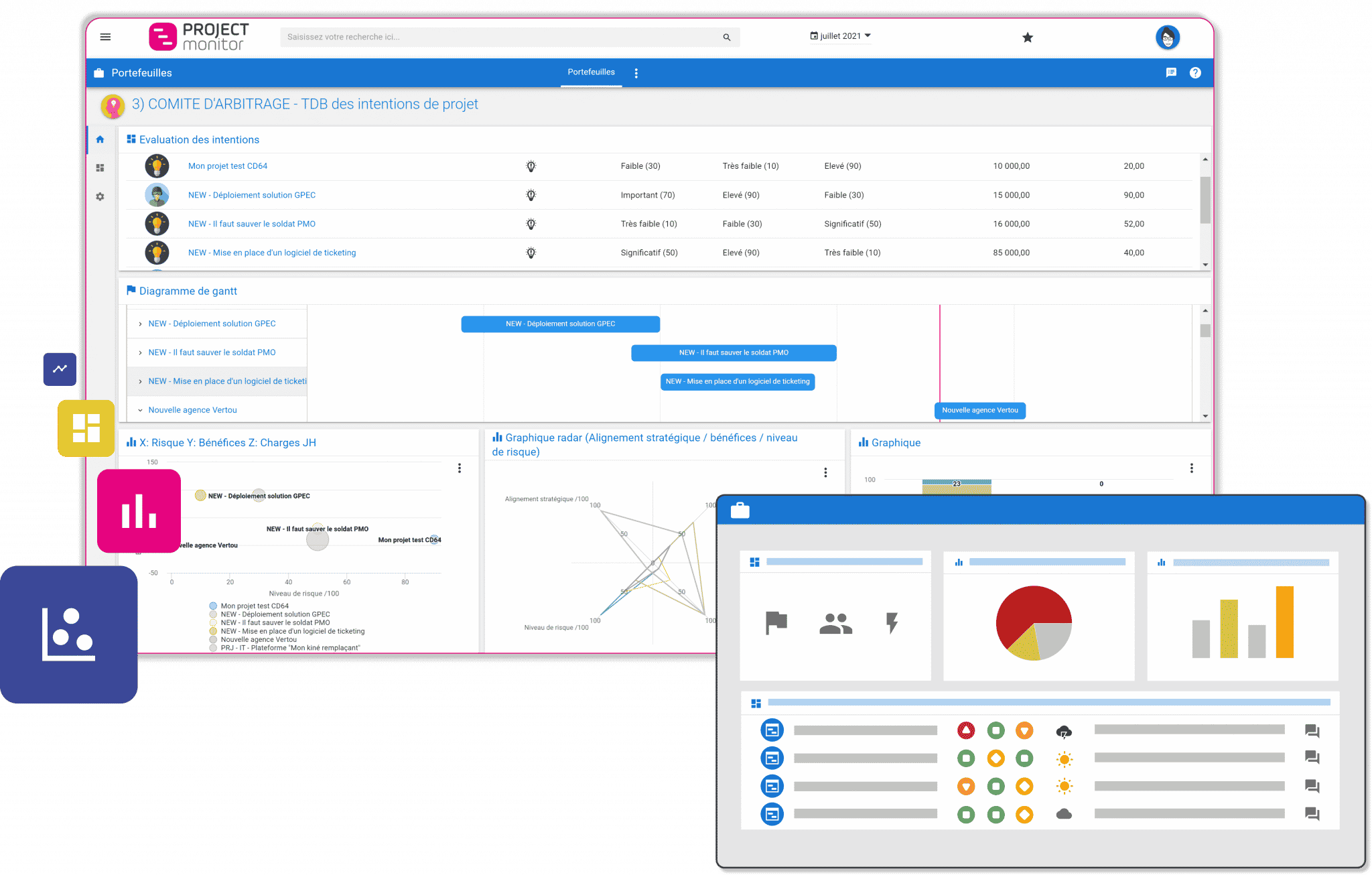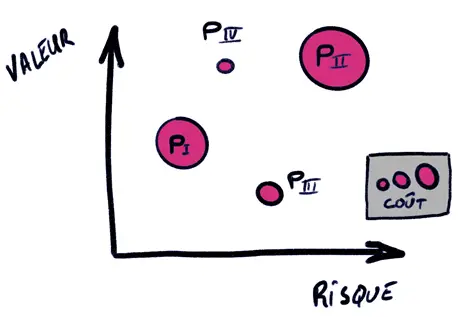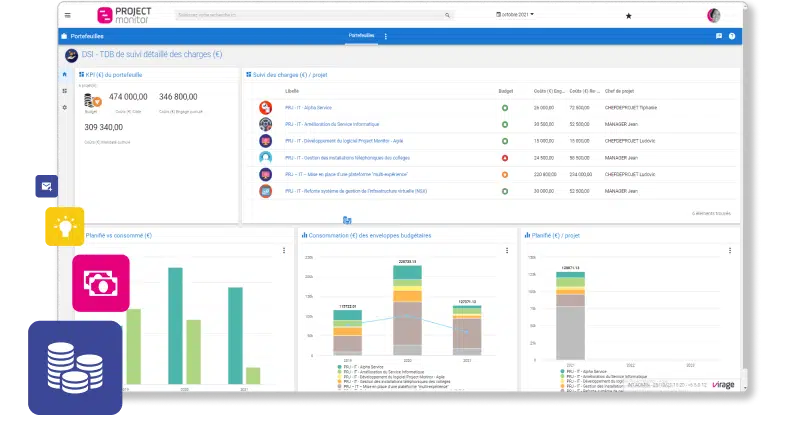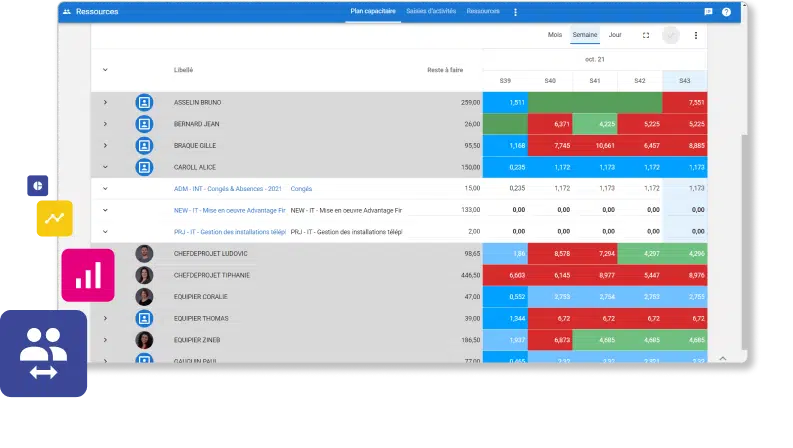Arbitrer les projets : Comment faciliter l’arbitrage en pilotage de portefeuille projets
Arbitrer les projets, c’est LA décision clé du pilotage de portefeuille de projets. De nombreuses entreprises ont du mal à trouver l’équilibre entre liste croissante de nouveaux projets, projets en cours et capacités de financement insuffisantes. Quel projet faut-il lancer ? Plus précisément quels projets intégrer au portefeuille de projets ? Comment prioriser les projets les uns par rapport aux autres ? Car sans vouloir spoiler la suite, l’arbitrage projet sera avant tout une décision de renoncement à des projets. Le bureau des projets ou le PMO enregistre plus de demandes que son entreprise est capable de réaliser. Les moyens manquent plus que les idées…
As a result, you want to make the best decision regarding the allocation of project resources. It's worth noting that the management of project requests is often cited by our customers as a process that has been drastically improved thanks to the PPM platform.
CONTENTS :
- Comment mettre en place un pilotage de portefeuille de projets ?
- What tools can be used to help arbitrate between projects?
- When it comes to arbitration, what can we know to inform the decision?
- Project decision must be informed by cost and impact
- Project membership: the final key to project prioritization?

Quels outils utiliser pour faciliter l’arbitrage en pilotage de portefeuille projets ?
Un logiciel de pilotage de portefeuille projets comme Project Monitor permet de construire automatiquement un graphique et de changer les axes analysés (budget, finance, risque, valeur, échéance, …). C’est aussi un outil très utile pour arbitrer les projets, réunir projets en cours et demandes de projets. Plusieurs fonctionnalités vous aident à prendre les bonnes décisions.
Configurable dashboards help you speed up project decision-making.
During your project reviews, it's essential to track the progress of the various monitoring indicators : schedule budget and resources, using appropriate evaluation tools.

The bubble graph visualizes the project portfolio and candidate projects.
A classic Project Portfolio Management tool can be used to bring together several decision keys: the bubble graph. It can be used to combine the keys of interest and the means to be mobilized. It also makes it easy to compare projects with one another. This 3-axis graph (x-axis, y-axis, bubble size) visualizes the project portfolio and candidate projects.

Flash reports for more detailed analysis
The aim is to provide a macro view of projects at a given date. The information to be completed for the committee is pre-filled according to a standard template, with the essential kpis. The project manager carries out his reporting and updates his project indicators. Data is consolidated in real time.
Web slideshows to animate governance bodies
From the portfolio dashboard, you can create governance bodies and animate them via a web slideshow. The slideshow can be configured to display the state of health of each project in the portfolio. With Project Monitor, the project session minutes are automatically generated and can be shared directly with collaborators.
Au moment de l’arbitrage en pilotage de portefeuille de projets, que peut-on savoir pour éclairer la décision ?
Identifier les enjeux du projet lors du pilotage des demandes projets
L’enjeu du projet : pourquoi cette demande arrive en arbitrage dans le pilotage du portefeuille projets ? La description du pourquoi, de l’objectif doivent primer sur la façon d’y répondre. Exprimer un besoin plutôt qu’une réponse « produit projet ». La réponse peut sensiblement différer à ce qu’on avait initialement envisagé. La soumission d’une demande doit permettre plusieurs réponses projets.
It's the purpose of the project that will also inform the interest in carrying out a project. Here are a few questions to ask yourself:
- Qui seront les bénéficiaires du projet ? L’interne ? Les clients ? les citoyens ?
- Is the project aligned with strategic priorities? To which strategic axes will it contribute?
- Does the project generate sales? If so, what are the revenue forecasts (optimistic, pessimistic)?
- Does the project aim to make a process more efficient? If so, what are the benefits?
- What value will the project generate?
To make these criteria objective, and thus enable prioritization according to the "challenge" axis, we can rely on "scoring" grids. The MAREVA method provides a reference framework for analyzing the value of a digital project, enabling projects to be positioned relative to one another.
The simple act of questioning is already a real plus. It allows us to get out of the "ask / do" cognitive rut, which is often biased by the "news" effect, the "authority" effect, the "decibel" effect.
Project requests, a key function in PPM software to channel portfolio flow
Project Monitor vous permet de définir des fiches projets ou fiches de demande personnalisées en fonction de vos besoins. Vous pouvez créer tous les critères d’analyse et de priorisation dont vous avez besoin : intérêt stratégique, niveau de risque, ROI, etc.
Each applicant updates his or her project before the prioritization meeting. Updates can be tracked in real time, according to user rights.
Depending on your organization's maturity, size and processes, candidate projects can follow a workflow-driven validation process.
Our Project Monitor solution allows you to create customized forms to describe your project requests and formalize their challenges :
- Quantitative field: an evaluation of requests according to your decision criteria
- Qualitative field: beyond the notes, describe what's at stake in the request. You'll be able to refer to it throughout the life of the project.
- Linking to strategic axes: the secret weapon for ensuring a balanced project portfolio
- Calculated value: equate, weight and score your criteria. A clever way to position your projects on a prioritization matrix and arbitrate projects easily.
- Form library: because an IT project is not described in the same way as a building construction project, the form is adapted to the type of request.
Arbitrate projects with a view to balancing the project portfolio
The balance of the project portfolio is measured on its support points:
- Strategic directions
- Direct and indirect beneficiaries of the project (or project owner)
- Project backers
- The project managers - we'll talk more about them later.
Arbitration must ensure that projects are evenly distributed. For example, are projects contributing to the strategic axis of sustainable development sufficient or are they surplus to requirements? In the case of territorial impact, the question may also arise as to the proportionality of project investments from a geographical point of view.
Arbitration at project AND portfolio level
We can also, as an industrial customer does, take a look at the time axis. Time measures not the duration of the project, but the expected impact of the project:
- "For yesterday": poorly-anticipated constrained projects (there are always some)
- Short-term: only projects subject to regulatory or legislative constraints
- Medium-term: project to optimize processes and existing facilities
- Long-term: investment, R&D and innovation projects
This reading grid is designed to ensure that we are preparing for the future. If you don't have any long-term profit projects in your portfolio, this is a danger signal. Short-term pressure tends to postpone, endlessly, decisions that will prepare the future. Long-term projects are the ones that will create tomorrow's value. Depending on the sector, innovation and investment are just as crucial as optimization.
Informing project decision-making by cost and impact
Consider the impact of the project according to the level of risk
Here is an initial list of questions to help "rough out" the decision, and which will need to be clarified in the event of a favorable decision:
- What is the level of technical mastery? Is this a completely new project? Is it a project that will use proven technology?
- What organizational novelty? "Project as usual" or a completely new approach? A totally new project scope
- How legally complex is the project?
- How much uncertainty - and therefore how much confidence - is there that the value will be achieved?
- How complex is the project's financial package?
- How dependent is profit on schedule ? Is time-to-market a determining factor?
These risk analysis grids depend on the sector of activity. An approach based on a list of questions is an effective practice. It can also be combined with a scoring system. Relative project risk scoring is more interesting than absolute scoring. In other words, compare two projects with each other: which is riskier? Enriching risk questioning grids with "Rexes" (project feedback) is a useful practice. Finally, when in doubt, it's a good idea to get an outside perspective on a project. In particular, to question the benefits of the project.
Analyze project feasibility
The second area is project implementation. This is the axis of project feasibility. From the point of view of the "project triangle", it's the analysis of the "costs" / "deadlines" summits.
In concrete terms, this means :
- Do we have the budget to carry out the project?
- Do we have the necessary resources (time and skills)?
- Do we have any overlaps between project deadlines?
Prioritize projects according to budgets
Project selection will also be based on economic criteria. Project budgets cannot be stretched to the limit, even if the value added can help finance unplanned projects. So choices will have to be made (and projects that are too expensive will have to be abandoned). The financial aspect of prioritization will depend on the culture and activity of the organization. In IT and building departments, for example, projects are at the heart of the business, and budgets are built for and around them. Project prioritization is therefore a two-stage process:
- First step: negotiating the overall budget for the project portfolio
- Second step: allocating budget resources to individual projects
Budgets are drawn up on the basis of an inventory of future projects, a financial estimate, and sometimes several scenarios. The structure or management will therefore first have a global negotiation phase to acquire resources for the project portfolio. Next, the resources are allocated to the projects. This allocation will be the subject of a second, more unitary arbitration, integrating the progress and financial execution of current projects.
This financially-informed arbitration process relies on a large amount of data that needs to be structured:
- Collection of project requirements, broken down by hypothesis
- Project budget monitoring
- Revised estimate of portfolio projects
- Investment schedule

✔ Prepare your project reviews and visualize the consumption of each project
A dashboard allows you to drill down into the details of each project to understand and analyze current projects.
This project-by-project analysis enables you to highlight non-compliant budget situations and quickly identify problems in the current and forecasted financial years. Simply unfold this project to understand the expenditure items that make up this batch.
Relying on resource workloads and capacity to deliver
If you have dealt with the elements in the order of the document, you have: a project aligned with the strategy, with identified impacts, with possible financing... that leaves the question of the project team:
Do you have the resources to carry out the project? This question can be asked from two angles:
- Do you have the skills? Do you have the right method for choosing the right project manager? The answer is "Make or Buy"... and a potential return to the budget.
- Do you have the availability or capacity to carry out the project? The workload of your teams will help you decide.
The answer on capacity will be all the more precise if you have established :
- An internal skills repository and modeling of "generic resources
- A forecast workload plan by "generic resources
- A forecast workload by "named resource
Sinon il reste l’incantation « ça devrait passer » mais elle n’apporte pas la meilleure garantie. Un logiciel de pilotage de projets vous permet de gérer sereinement la capacité de vos ressources projet. Passez à la planification proactive de vos projets !
Project membership: the final key to project prioritization?
If there's still any doubt at this stage, a visit to schedule will complete the "go / no go" decision process.
A project is never carried out in a "bubble". It is carried out among other projects. And while these other projects can compete with budgets and resource allocations, they are sometimes direct "predecessors" or "influencers". This is where the notion of rendezvous and milestones in project dependency comes into play.
The decision may therefore be "yes", but not right away. This delay is motivated by :
- A concentration of major deadlines over a given period
- Chaining of deadlines and the need to keep the predecessor under control
- Time to wait for key players to become available to take on projects
Multi-Gantt projections of the project portfolio will shed some very interesting light on this subject.

✔ Allocating the right resources at the right time
Le logiciel de pilotage de portefeuille Project Monitor vous offre la possibilité d’articuler votre plan de charge par rapport à la capacité de vos ressources pour une meilleure affectation des activités récurrentes, gestion des congés et absences et planification des projets. L’outil de planification des ressources Projet Monitor vous propose une nouvelle génération de planning automatique avec une mise à jour en temps réel. Cet outil d’accompagnement de gestion des ressources vous alerte en permanence des sous effectifs et des sureffectifs.
All that's left is to decide on your projects 🙂
We have explored the variables and decision keys for arbitrating projects. The aim of this inventory is to reduce the uncertainty involved in prioritizing projects. It remains a complex process that involves a certain amount of "gambling".
- Time prioritization key: When should the project be carried out? What are the major deadlines? What are the dependencies on other projects?
- Budget arbitration key: how much for the project phase, how much for the Run?
- Resource" prioritization key: who will carry out the project, for how many days? what skills should be mobilized?
- Benefit variable: how much will the project contribute (and when)?
- Risk variable: what level of risk
- Barycentre variable: what a balance
Request a demonstration of the PPM tool Project Monitor
Project Monitor is designed for organizations with more than 50 employees and over 100 active projects. Simplify your project management with an all-in-one tool: multi-project dashboards, workload planning, schedule, tasks, IT request tracking, and budget monitoring. Discover the features of Project Monitor through a personalized live demonstration with one of our experts.
Insights from our project experts on your challenges
Key points of possible functionalities
Customized settings and concrete examples based on your objectives
Simple, free and without obligation!
Key software features Project Monitor to manage your project portfolio
Dashboard indicators
Time tracking
Ideas & requests
Project tracking & Gantt
Capacity schedule
Budgets
Task management & kanban
Reporting
Other frequently asked questions about project arbitration
What's the best way to group projects into portfolios?
With the development of the project mode, organizations have to manage hundreds of simple or complex projects. It's not possible to keep track of these projects one by one. So it's natural to group them into project portfolios for better management. In this article, you'll find advice on how to build your project portfolio.
How do you manage requests for new projects to be included in the portfolio?
To manage requests for new projects to be included in the portfolio, it's important to establish a clear, structured process. Receive project requests and assess their relevance to the organization's strategic objectives. Analyze the potential benefits, resources required, risks and impact on the existing portfolio. Find out more in this article on How to manage project requests.